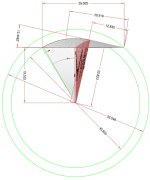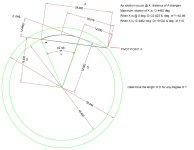I am an old man who can't remember much when it comes to geometry.
I am trying to calculate the numbers on this diagram. I have drawn them in autocad, but need to get real numbers in my PLC.
As the object rotates between 0 and 12.4462 deg. Calculate the distance from the center of the circle to the intersecting line.
What would be the formula to generate these numbers?

I am trying to calculate the numbers on this diagram. I have drawn them in autocad, but need to get real numbers in my PLC.
As the object rotates between 0 and 12.4462 deg. Calculate the distance from the center of the circle to the intersecting line.
What would be the formula to generate these numbers?







